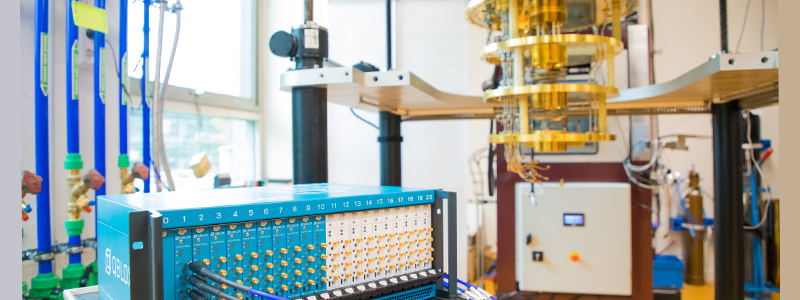13.07.2020Quantum Computing
QuTech researchers are the first to build a single-hole qubit

QuTech researchers are the first to build a single-hole qubit
One of the key challenges in building the much coveted and very powerful quantum computer is the building of qubits (quantum bits) that can be scaled to large numbers. Using only standard semiconductor manufacturing techniques, researchers from QuTech have now demonstrated that a single hole, trapped in a germanium quantum dot, can be effectively used as a qubit. Their work was published in Nature Communications on July 10.
Transistors, semiconductor devices, are the key active components in nearly all modern electronics and therefore the most replicated manmade structure in the history of mankind. Charge carriers within these semiconductors can be either electrons or holes – a hole being the lack of an electron where one could exist in the semiconductor’s atomic lattice. Over the past decades, semiconductor manufacturing techniques have advanced to the level of creating nanometre-size structures capable of trapping of few or even a single of these charge carriers, a scale at which quantum behaviour is dominant. Remarkably, research into semiconductor materials for building qubits has historically almost exclusively been focussed on the use of electrons.
A hole with favourable characteristics
A hole is not a real particle but rather a quasi-particle. It does, however, have favourable properties that could make could make it an excellent building block for a quantum computer. Single holes can maintain their quantum state for a long enough period of time to allow quantum computations. They can also be manipulated using electrical signals only, thereby limiting the need for external components to control them and allowing easier upscaling. These properties were predicted already in 2005 but until now it had not been possible to isolate a single hole and use it as a qubit. The group of Menno Veldhorst at QuTech – a collaboration between TU Delft and TNO – have now achieved this feat.
Back to germanium
The very first transistor ever made, in 1947, consisted of the material germanium. Nowadays, most semiconductor devices are made of pure silicon and, therefore, most research into scalable cubits has been based on the use of silicon. Two years ago, however, the QuTech group of Giordano Scappucci showed the feasibility to build germanium structures of the high-quality needed for qubits. Now, Menno Veldhorst and his colleagues have built a germanium quantum dot (a semiconductor particle only a few nanometres in size) capable of trapping a single hole. ‘Germanium quantum dots have all the essentials,’ Veldhorst explains. ‘They are made with the same technique as used to put billions of transistors on a classical computer chip. We imagine that, with germanium, qubits can be scaled up in the same way.’
Scaling up
The current results are the culmination of a series of breakthroughs in quantum computing the group of Veldhorst achieved using germanium. Earlier this year, and also in Nature, they published on the first realisation of two-qubit logic with germanium. They are now working on building larger qubit arrays made out of holes in germanium, bringing scalable qubit systems, and therefore the quantum computer, ever closer.
More information:
A single-hole spin qubit
N.W. Hendrickx, W. I. L. Lawrie, L. Petit, A. Sammak, G. Scappucci & M. Veldhorst
Nature Communications 10 July 2020
https://doi.org/10.1038/s41467-020-17211-7
Contact:
For more information you can contact:
Menno Veldhorst, Group leader at QuTech and roadmap leader QuTech Academy
m.veldhorst@tudelft.nl
Photo credit:
Luca Petit


